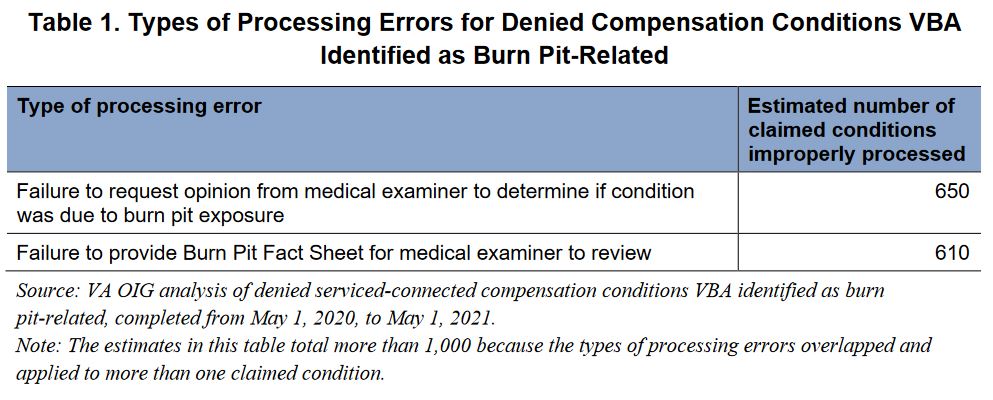WASHINGTON, DC — With the passage of the PACT Act last month, Congress is demanding that VA put burn pit exposure at the forefront of its healthcare and benefits processes. The legislation added 23 presumptive conditions to the list of those related to burn pits and other environmental hazards. The intention is to make it easier for veterans to receive VA healthcare and benefits.
A recent VA Office of the Inspector General (OIG) report demonstrates how sorely this is needed, showing that VA has prematurely denied compensation to a large percentage of veterans submitting burn pit related benefits claims, as well as failing to consider burn pit exposure for conditions associated with toxic exposure.
A separate report also found fault with VA’s Burn Pit Registry, suggesting the department is missing out on a substantial amount of veteran data that might aid future research into burn pit exposure.
Examining samples of denied veterans benefits claims, OIG investigators found that VBA staff incorrectly processed 870 of 1,000 conditions that veterans identified as related to burn pit exposure. Of those 870,630 had the potential to affect veterans’ benefits. According to the report, VBA failed to obtain additional evidence, such as a medical opinion, before making their determination.
“The premature denials were due in part to confusing guidance for processing conditions potentially related to burn pit exposure, the VBA application used to request medical examinations not including burn pit exposure in its list of options, and a lack of oversight,” the report states.
Investigators also looked at a sample containing the five most frequently claimed conditions related to burn pit exposure: bronchial asthma, chronic bronchitis, allergic rhinitis, sleep apnea and chronic obstructive pulmonary disease. It’s estimated that VBA denied more than 4,200 of these conditions between May 2020 and May 2021. The OIG team estimates that VBA staff improperly processed 97% of them, with the vast majority of those having the potential to impact veterans’ benefits.
Because veterans will not necessarily know about the dangers of environmental hazards like burn pits, VBA policy states that claims personnel should know about the hazards and adjust claims accordingly.
“VBA staff and managers at multiple regional offices noted that staff may forget to consider exposure when it is not explicitly claimed by the veteran,” the investigators wrote.
VBA updated its burn pit exposure guidance in June 2022 to note that emissions’ exposure is now recognized in the Southwest Asia theater for veterans serving after August 1990, as well as in several other regions. However, in the revisions process, VBA removed the guidance, noting that its staff has a duty to consider exposure to environmental hazards, even if veterans don’t include it in their claim.
Recommends Review of Cases
While the PACT Act might address many of these issues moving forward, the OIG recommended VBA go back and review the cases OIG identified as being prematurely denied.
There also are flaws with VA’s Burn Pit Registry, according to a separate OIG report. The registry includes a 140-item questionnaire for veterans to fill out. Then it’s the veteran’s responsibility to schedule an exposure-specific exam.
According to investigators, the questionnaire can take up to an hour to complete, with veterans reporting they found the directions on scheduling confusing.
The questionnaire was not completed by 158,200 veterans who started it. Of those who finished, only 15% went on to schedule and complete an exam.
“The questionnaire did not make it clear to veterans that they, not VHA, had to reach out to schedule the exams,” the report states. “Because VHA placed the burden on veterans to schedule their registry exams, medical facilities were not required to follow up with veterans who indicated on the questionnaire they wanted an exam but had not scheduled it. However, program and facility staff indicated in interviews that some veterans expected medical facilities to contact them regarding scheduling.”
Unsurprisingly, those facilities that voluntarily reached out to veterans, either by emailing or calling them, are the ones that have performed the most exams.
OIG’s recommendations are relatively simple: Revise the questionnaire to be more veteran-centric, and make sure that veterans who are interested in an exam understand how to receive one.
The Burn Pit Registry was established in 2014 to help VA better understand the health impacts of environmental hazards. Since then, more than 200,000 veterans have chosen to be included on the registry.
The PACT Act includes language that directs VA to make sure all veterans presenting at a VA facility with conditions that could be related to burn pit exposure are informed the registry exists. It also requires VA to break down participants by state and congressional district and to make that information public.

